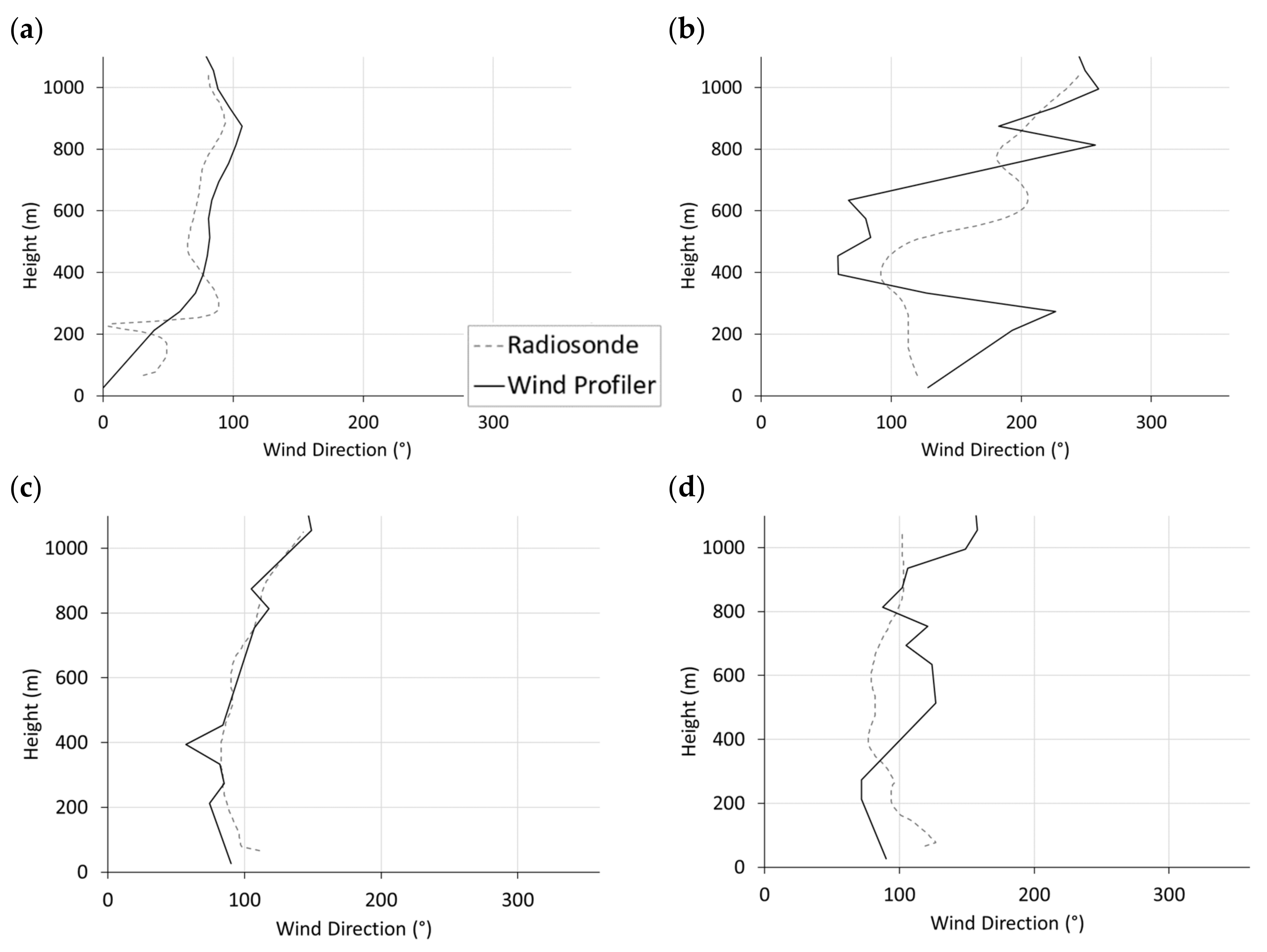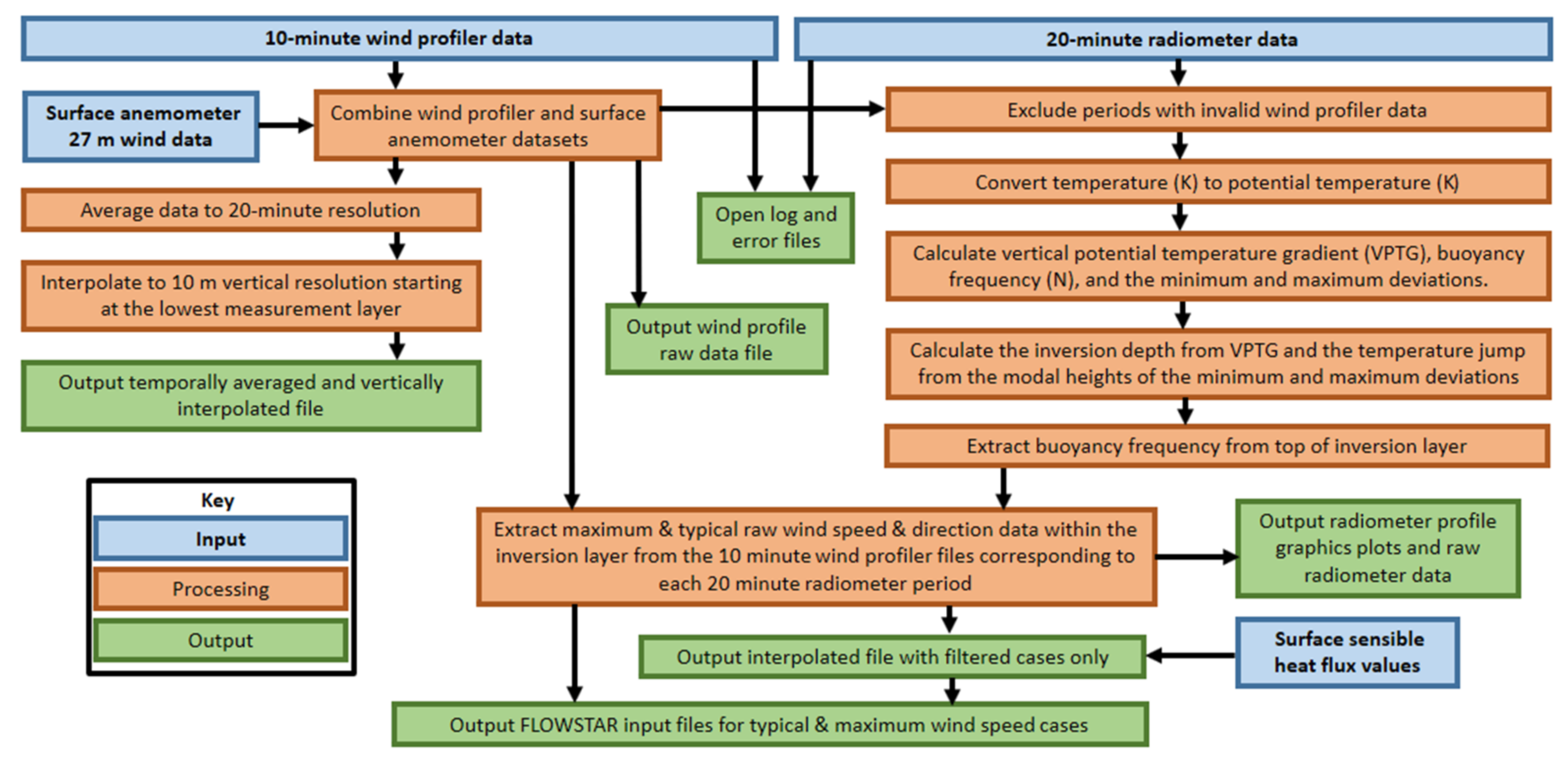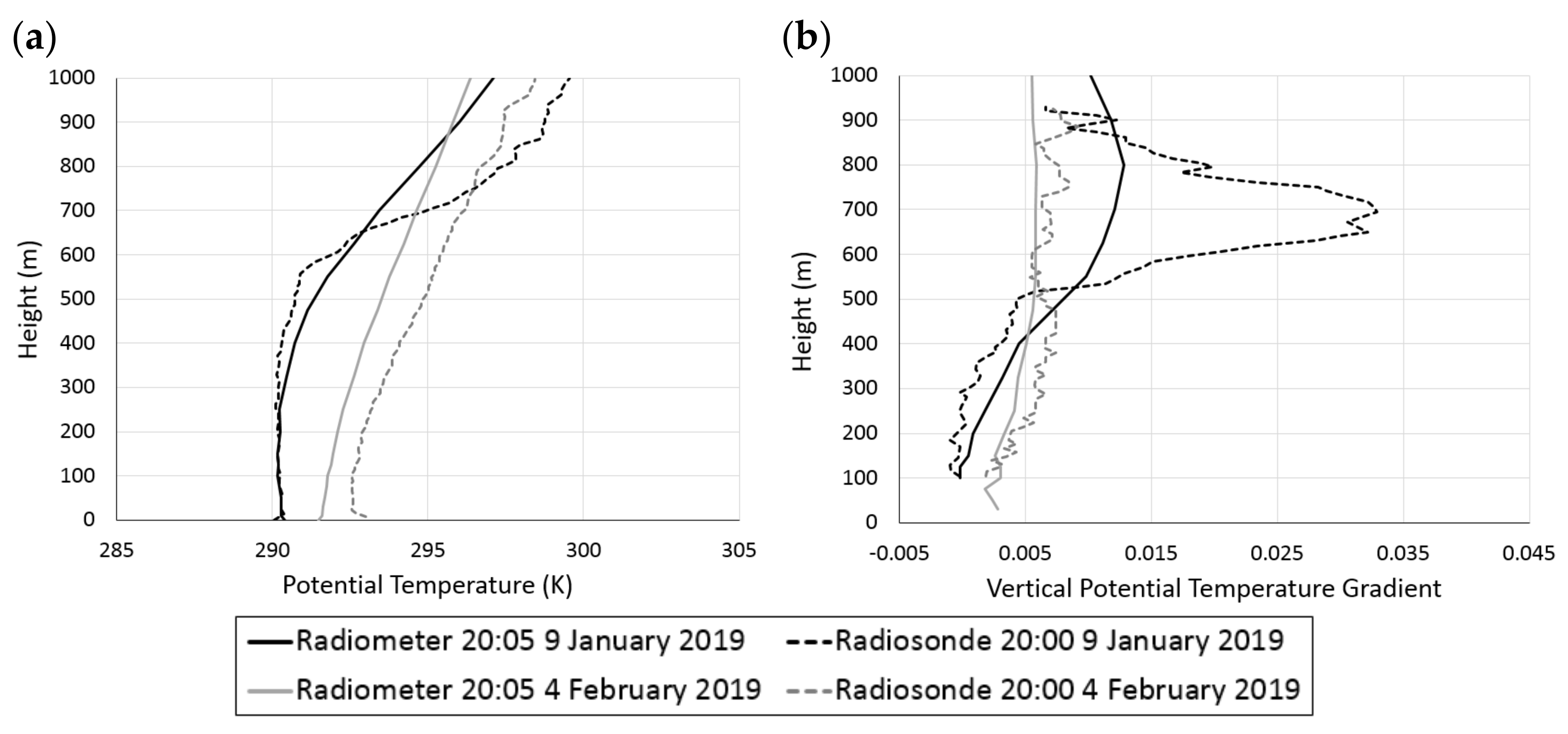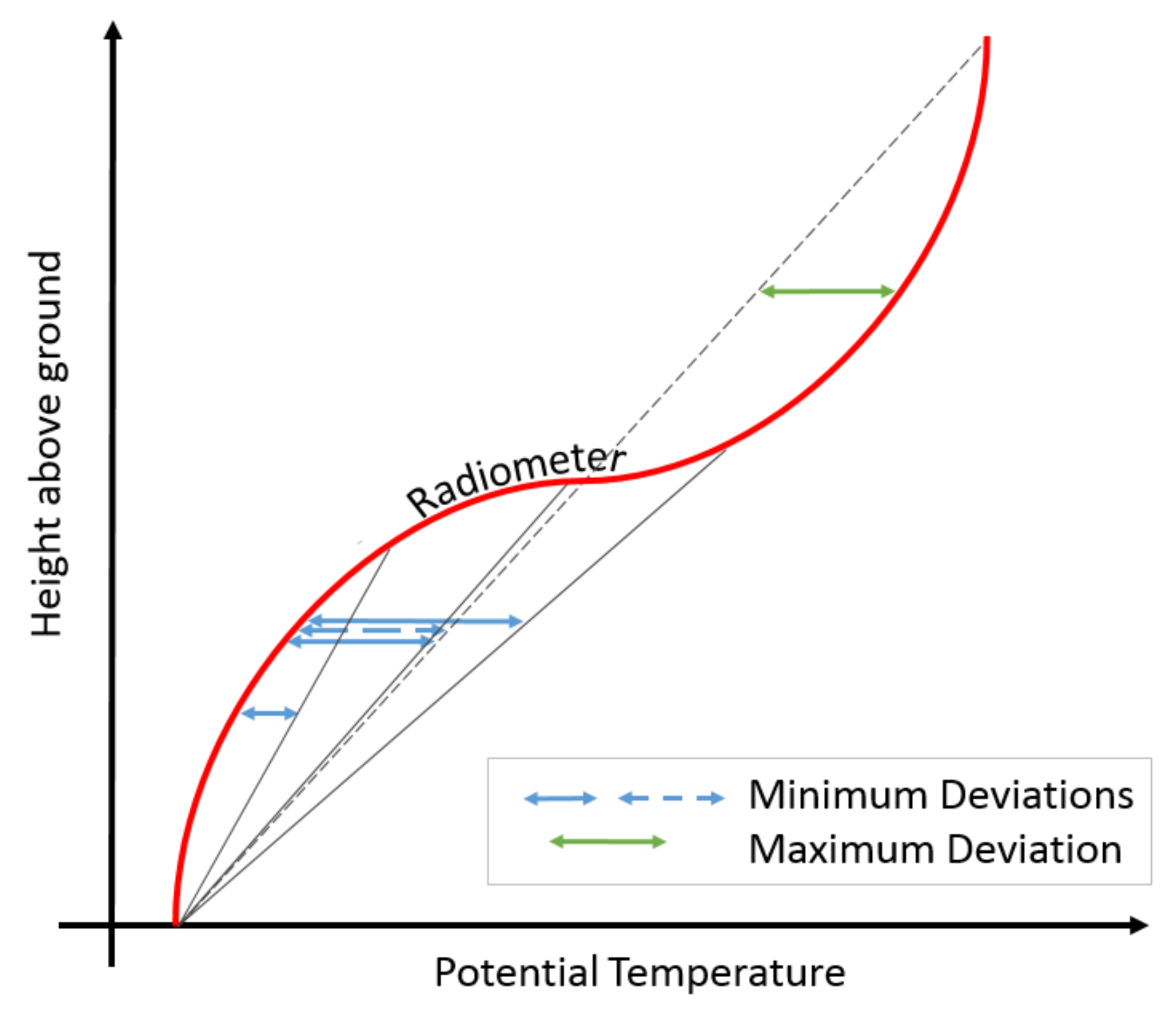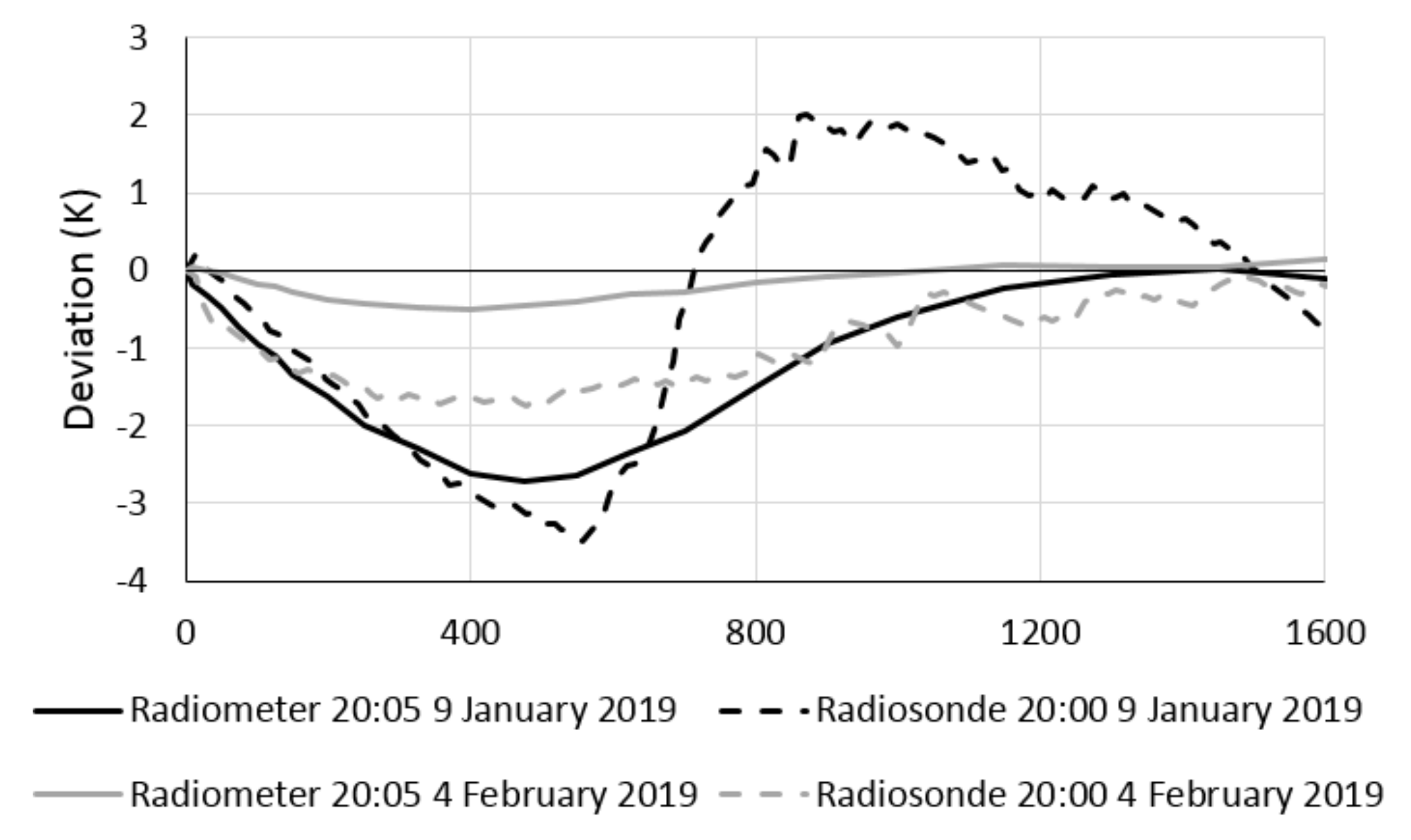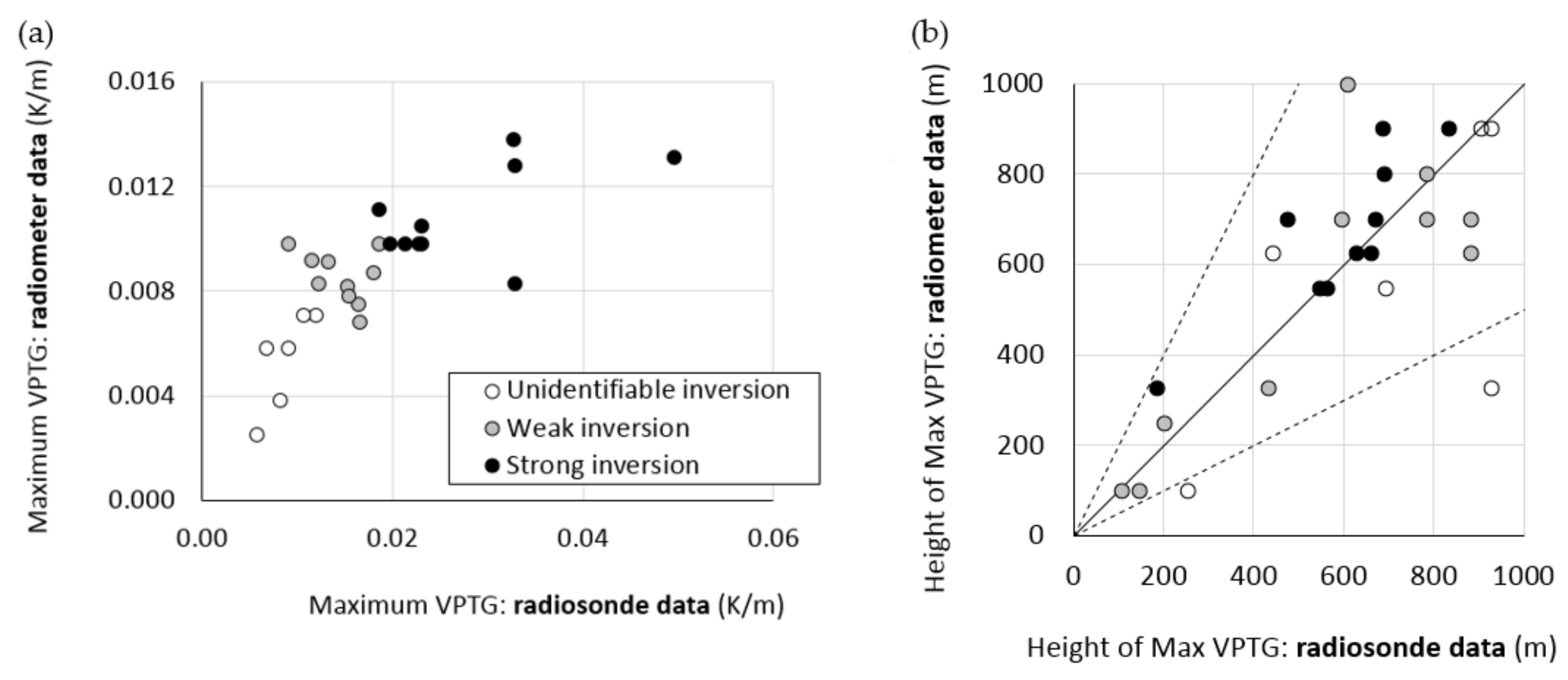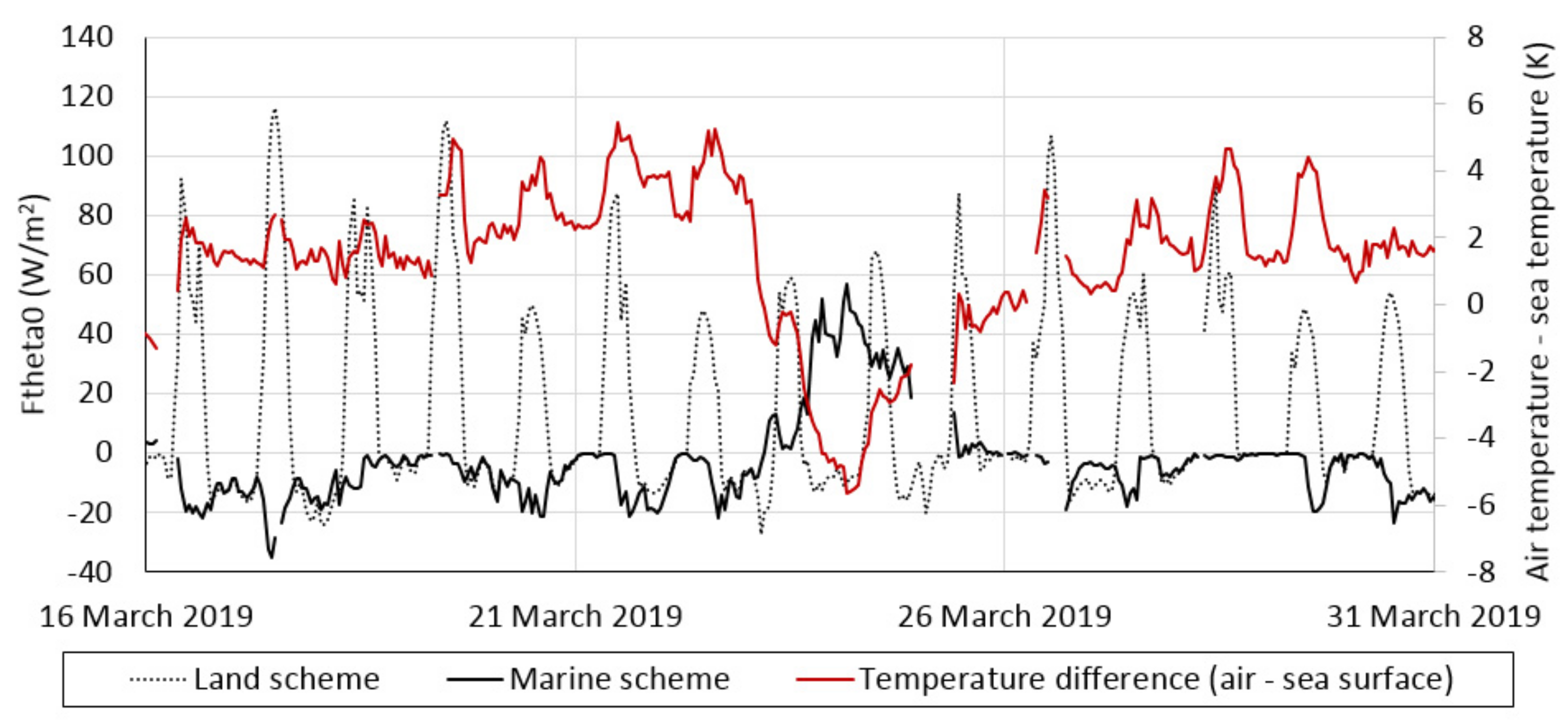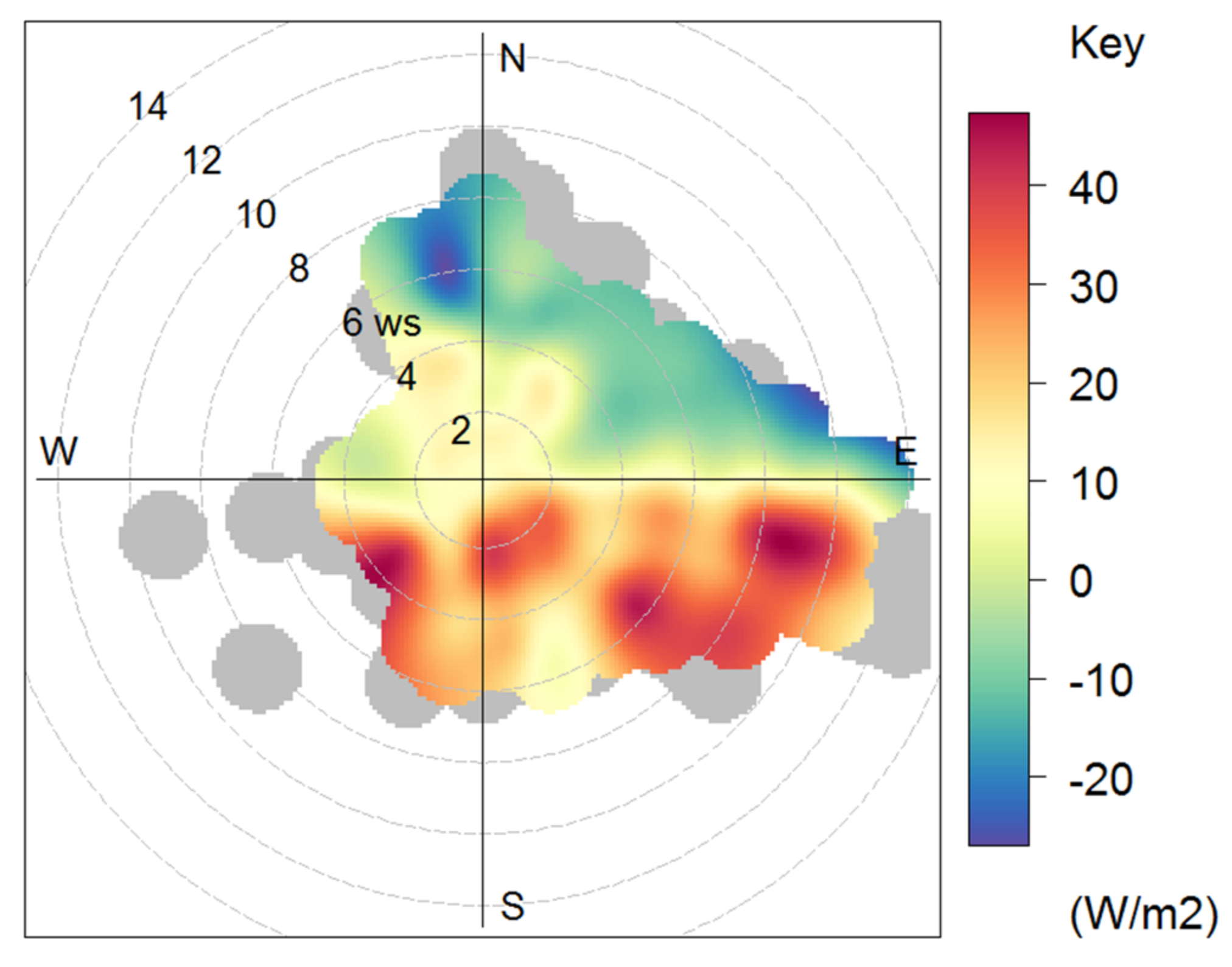1. Introduction
Aircraft landing at airports located in the vicinity of significantly elevated terrain may experience less than ideal meteorological conditions due to the influence of mountains on air flow and turbulence. Aircraft landings at Hong Kong International Airport (HKIA) have been subject to episodes of significant wind shear and turbulence since opening in 1998 [
1]; HKIA is located on reclaimed land to the northwest of Lantau Island, which has a maximum elevation of nearly 1000 m. There are many other airports which experience similar problems, such as the island of St Helena in the South Atlantic, where landings have been disrupted due to turbulence generated by the elevated terrain to the northeast of the airport [
2], as well as Bodo (Norway), Punta Arenas (Chile), Comodoro Rivadavia (Argentina) and Dutch Harbor (Alaska).
If pilots have advance warning of adverse conditions, with the assistance of air traffic control personnel, appropriate action can be taken to avoid dangerous landings, for instance, use of alternative runways or airports [
2]. Such warning systems can be developed through application of a variety of methods, such as deployment of instrumentation near the airport [
3] or use of numerical weather prediction (NWP) models to calculate flow and turbulence fields [
4]; systems may use a combination of both of these approaches [
5]. Alternative solutions to similar complex, non-linear problems involving multiple variables may be found through the application of machine learning, for instance, using neural networks to optimize aerodynamic parameters in relation to unmanned aerial vehicles [
6].
Some NWP models configured to represent current weather conditions at airports require real-time meteorological measurements as input. One accurate source of meteorological measurement data is radiosonde soundings, but these are only taken 6- or 12-hourly, so have insufficiently high temporal resolution for use as input to a now-casting system. Radiosonde data are, however, useful for assessing the accuracy of other higher temporal resolution datasets.
Multiple high-temporal resolution measurement instruments have been deployed by the Hong Kong Observatory in the vicinity of HKIA and on the mainland at King’s Park (Yau Tsim Mong) that can assist with identifying adverse weather conditions, specifically surface anemometers, wind profilers, weather buoys, a light detection and ranging (LiDAR) instrument and a microwave radiometer. Studies have been undertaken reviewing the measurement datasets recorded by these instruments and in some cases, additionally data from equipment onboard aircraft. Inter-comparisons of measurements taken using different equipment are presented in the literature, in addition to comparisons of measurements against numerical weather prediction (NWP) model data. A detailed description of HKIA weather buoy stations has been published [
7], with the aim of using the data for wind shear estimation, and comparisons of LiDAR scans against meteorological measurements recorded by surface anemometers and weather buoys have been undertaken [
8]. A particular wind shear episode has been investigated by looking at LiDAR, on-board records and NWP data [
9], and vortex/wave shedding in the vicinity of HKIA during an event in 2014 has been studied, making use of surface anemometer and wind profiler measurements for evaluating NWP model performance [
10]. LiDAR and weather buoy observations have been used to evaluate high-resolution NWP model performance for particular adverse conditions [
4], and the same system was further evaluated for a two-year period by comparison with pilot wind shear reports in [
11]. A methodology for the use of anemometer, LiDAR and microwave radar data in operational wind shear algorithms has been developed [
3]. In addition to these literature studies, Hong Kong Observatory publishes accessible information on wind shear and turbulence for pilots and air navigators, including details of the Hong Kong aviation weather alerting service [
12].
Mesoscale NWP models such as the Weather Research and Forecasting (WRF) model developed by the US National Centre for Atmospheric Research (NCAR) can be applied at a range of scales, from tens of meters to thousands of km. When run at fine resolution, the model can be used to capture terrain-disrupted airflow. Hong Kong Observatory (HKO) have developed a system incorporating WRF that resolves air flow at 200 m resolution in the vicinity of HKIA [
4]; the system has been shown to capture complex air flow features that occur in this region, specifically foehn winds [
13] and mountain waves [
14].
The FLOWSTAR model [
15] is a quasi-linear, steady state perturbation model which characterizes the atmosphere using up to three layers comprising a boundary layer, where, near the surface, account is taken of the impact of upwind shear and locally generated turbulence on the perturbations in mean flow; an elevated inversion layer; and a stable layer aloft where the terrain may generate both propagating and trapped internal gravity waves. By configuring FLOWSTAR with terrain and meteorological datasets corresponding to the topography and atmospheric conditions in the vicinity of HKIA, it has been possible to broadly reproduce the large-amplitude mountain waves generated by air masses passing over Lantau Island that can lead to wind shear conditions at the airport [
16,
17,
18]. Specific meteorological conditions lead to mountain waves, namely, a combination of high wind speeds, a strong low-level elevated inversion with a large temperature jump and relatively low buoyancy frequency at the top of the inversion. In order for the FLOWSTAR model to form part of a wind shear now-casting system, real-time estimates of a number of inversion-layer parameters are required: height, wind speed (typical/maximum), wind direction and temperature jump. In addition, the model requires an estimate of the surface sensible heat flux, the buoyancy frequency above the inversion layer and a representative wind direction profile, the latter required because the core model only allows for one input wind direction. The purpose of this paper is twofold. Firstly, following identification of suitable measurement instruments, processing methodologies that allow generation of the required FLOWSTAR input parameters are presented. Secondly, the accuracy of the wind- and temperature-related, high-resolution datasets is evaluated using more precise radiosonde data; other evaluation techniques are presented for the surface sensible heat flux parameter.
The aim of the current work is not only to derive meteorological parameters suitable for use in a now-casting system but also to apply an initial filtering of the meteorological data into time periods that are more (or less) likely to lead to adverse conditions at HKIA. This is problematic because mountain waves are not the only cause of adverse weather conditions at the airport: strong wind veering and combinations of other wind/atmospheric conditions prevalent in mountainous regions may also generate sharp headwind changes [
19]. For the current study, the meteorological data are filtered for cases where the FLOWSTAR model may predict mountain waves.
The methods section reviews meteorological measurement data availability in the vicinity of the airport. Meteorological processing methods are then presented, separately for the radiometer, wind profiler/anemometer and weather buoys. Key outcomes of the evaluation of the derived datasets are then given. The paper concludes with a discussion of the relative merits of the processing techniques developed, the evaluation results and recommendations for improvements to the current approach.
2. Methods
Meteorological measurement availability is presented in
Section 2.1, and meteorological processing methods are described in
Section 2.2. Where informative, data examples from the period January to April 2019 are presented; more comprehensive results from the processing of measurements for this period are presented in the results section.
2.1. Meteorological Measurement Availability
HKO has a network of instruments that record meteorological data over the Hong Kong Special Administrative Region (HKSAR). The majority of the instruments are automatic, recording meteorological parameters at high temporal resolution; details of the instrument type, location height and parameters measured are given in [
20].
Figure 1 shows the domain over which the measurement instrumentation relevant to this study has been deployed. King’s Park (KP) in Kowloon is the site for the radiometer; wind profiler data and surface anemometer data are taken from Cheung Chau Island (CCH) to the southeast of Lantau Island; sea surface temperature and air temperature are taken from weather buoys 1 and 4 (WB1, WB4) close to the airport. In addition to the mountainous terrain, the marine environment also influences meteorological conditions at the airport;
Figure 1 shows HKIA in relation to the Pearl River estuary, which is of relevance to the surface sensible heat flux calculations. The HKIA northern and southern runways are shown for reference.
A number of meteorological parameters are required as input to the FLOWSTAR model. Specifically, the strength of the temperature inversion, the wind speed in the inversion layer, the buoyancy frequency above the inversion layer and the inversion layer height are the dominating meteorological parameters that influence the generation of mountain waves at HKIA; atmospheric stability in the boundary layer is also important, and a wind direction vertical profile is required in order to re-combine multiple FLOWSTAR model outputs, as the core model only allows for one input wind direction. In previous work, these parameters were derived from archived meteorological datasets recorded in the vicinity of HKIA but for a now-casting application, real-time data model inputs are required.
Table 1 compares the meteorological parameter data sources used for previous hindcasting applications [
16,
17,
18] and for the current now-casting method. Specifically, the majority of hindcast meteorological data were derived from radiosonde soundings. Radiosonde data provide an accurate record of meteorological parameters within the boundary layer, at high vertical resolution. Temporal resolution of radiosonde measurements is, however, very low (six or twelve hourly); this low temporal resolution makes radiosonde data unsuitable for use in a now-casting system.
Real-time radiometer data provide temperature measurements at high temporal and vertical resolution. As for the radiosonde dataset, potential temperature profiles can be derived from radiometer temperature profiles. For a particular profile, a step-change in potential temperature indicates the presence of an inversion layer; where the inversion layer can be detected, the required associated parameters (inversion height, potential temperature jump and buoyancy frequency) can be derived.
Radar wind profiler data available from CCH have been used in earlier work (to estimate wind speed and direction in the inversion layer, [
17]), and these data are available in real time. The wind profiler functions in two modes, each recording at two-minute intervals, at vertical resolutions of 200 and 60 m, with the latter datasets used for this study. The wind profiler precision is 1 m/s for wind speed and 10° for wind direction.
Table 2 provides details of the temporal and vertical resolutions at which this dataset is available; other real-time datasets are also summarized in
Table 2. Of note here is that the lowest data record of wind by the profiler is approximately 200 m above ground level. As the current study focuses on aircraft landings within the lowest 400 m, further quantification of the near-surface boundary layer structure is required, which can be provided by the CCH surface wind station at hourly resolution.
Previous studies of FLOWSTAR applications at HKIA involved study of high wind speed conditions, for which an assumption of a neutral atmospheric boundary layer was justifiable. For the current work, a full range of atmospheric conditions must be considered because the now-cast is applied for all time periods. An estimate of surface sensible heat flux is therefore needed to define the boundary layer structure within the model; off-shore, this parameter can be approximated through application of a marine boundary layer scheme, which requires a quantification of the temperature difference between the sea surface and the air, as well as wind speed magnitude. Such data can be provided by the HKO weather buoys, which supplement land-based weather stations by providing weather information at sea, where meteorological recordings are sparse.
The third column of
Table 2 states the temporal resolution of the datasets used to generate now-casting input for the FLOWSTAR model; the resolutions range between one and sixty minutes. All measurements must have the same temporal resolution and correspond to the same time period if they are to be used as now-casting model inputs. Time-averaging can be applied to fine resolution measurements to associate them with a longer time period, but averaging smooths out high frequency variations; conversely, interpolation methods can be used to approximate shorter time period parameters from low-resolution measurements, but the accuracy of the interpolated values reduces for shorter time periods because stochastic fluctuations are not accounted for. To achieve a balance between averaging and interpolation, a temporal resolution of twenty minutes was selected, coinciding with the radiometer times (5, 25 and 45 min past the hour).
The fourth column of
Table 2 provides information relating to the vertical resolution of the datasets. In contrast to the temporal measurement frequency, it is not necessary for all datasets to use the same vertical resolution because they are processed independently. However, at the final stages, interpolation is applied to generate a regularly spaced wind direction profile.
The multiple meteorological processing methods applied to derive model input parameters from the available real-time datasets are described in the following sections. All reported times are in local time (Hong Kong Time, HKT).
2.2. Meteorological Processing Methods
The height of the inversion layer is required in order to calculate wind parameters in the inversion layer, and the inversion layer is identified through inspection of the processed potential temperature profiles which are derived from the radiometer measurements. Thus, in the following sections that describe the meteorological processing methods, the radiometer methodology is presented first. Subsequent derivation of wind parameters is then described, followed by the calculations of surface sensible heat flux.
Figure 2 presents a flow chart that outlines key inputs, outputs and processing steps associated with the wind and temperature data processing. Processing details of the surface sensible heat flux calculations have been omitted from this flow chart because the marine boundary layer scheme calculations have been performed within an alternative model application, ADMS 5 [
21] i.e., bespoke processing scripts were not required. ADMS 5 is an atmospheric dispersion modelling tool developed by Cambridge Environmental Research Consultants (UK), used extensively by commercial, research and regulatory organizations worldwide for the calculation of air quality impacts resulting from the release of atmospheric pollutant emissions from industrial installations. The model includes a meteorological pre-processing module that derives meteorological parameters used to describe the atmospheric boundary layer, such as surface sensible heat flux, from meteorological measurement datasets; this module has been used for the marine boundary layer calculations described here.
The methods described in the following sections describe the meteorological processing steps for valid data points; error handling to allow for invalid and missing data has been included in the processing, but full details have been omitted for brevity.
2.2.1. Radiometer Data Processing
Inspection of radiometer data indicates that values compare well with the more reliable radiosonde temperature records in terms of overall values, but the gradient does not appear to detect elevated temperature inversions; this has been reported previously in the literature [
22].
Figure 3a presents an example demonstrating this (20:00 9 January 2019), where the radiosonde clearly indicates a temperature inversion between approximately 550 and 850 m; the radiometer does not detect the changes in gradient with height shown by the radiosonde.
Figure 3a also presents the same comparison for a different time (20:00 4 February 2019), when no clear inversion is detected by the radiosonde; the profiles compare well for the first few hundred metres, but accuracy decreases with height. However, despite the radiometer’s inability to precisely capture the potential temperature variations with height, the similarities between the profiles provide motivation for development of methods that extract the required information from the high temporal resolution radiometer data.
Estimates of boundary layer height, potential temperature jump in the inversion layer and the buoyancy frequency at the top of the inversion layer must be derived from the radiometer data (
Table 1). The most straightforward way to derive an estimate of the boundary layer height for atmospheric conditions in which a temperature inversion is present is to calculate the maximum gradient with respect to height above ground of the potential temperature profile.
Figure 3b compares example radiosonde and radiometer vertical potential temperature gradient (VPTG) profiles, where the VPTG is calculated using potential temperature values from immediately below and above the specified height. The strong inversion case (9 January) shows that whilst the magnitude of VPTG for the radiosonde is much greater than that for the radiometer, both temperature gradient profiles have clear maximum values in near-identical locations. Conversely, neither radiosonde nor radiometer VPTG values for the 4 February indicate a clear maximum value. Of note here is that there is much less ‘noise’ associated with the radiometer VPTG profiles compared to the corresponding radiosonde profiles, which simplifies the identification of the location of the maximum value, although there are some sharp changes in near-ground profiles.
Following the identification of the temperature inversion height from the radiometer profile data, a novel approach has been developed to estimate the corresponding inversion strength, by amplification of the profile variation. Inspection of
Figure 3a and multiple other potential temperature profiles leads to the conjecture that a profile with a strong inversion has a distinctly non-linear profile; conversely, where no inversion is present, the potential temperature increase is close to linear. Thus, if minimum and maximum deviations from linear increases in potential temperature profiles are calculated, then the magnitude of the temperature jump may be estimated.
Figure 4 presents the variation of an idealized radiometer potential temperature profile with height. The concept of the calculation of deviations from a linear profile (i.e., straight line) starting at the ground and increasing with height at equally spaced intervals is shown. For each linear profile, a series of values corresponding to the temperature difference between the straight line and the radiometer profile are calculated, corresponding to each linear profile height value; these differences can be negative or positive. Then, for each linear profile, the ‘minimum deviation’ is set equal to the largest magnitude negative difference between the profiles (indicated by the blue arrows in
Figure 4) and the ‘maximum deviation’ is set to the largest magnitude positive difference between the profiles (the green arrow on
Figure 4). A series of minimum and maximum deviations are calculated (i.e., one for each height above the ground), and the corresponding height of the minimum/maximum deviation is recorded together with the associated potential temperature value. As can be seen by the schematic (
Figure 4), heights corresponding to relatively sharp gradient changes are recorded repeatedly; this method allows the application of a ‘modal’ approach to identification of the location of the minimum/maximum deviation from a linear profile; the temperature jump is estimated by the difference between the potential temperature recorded at the height of the maximum deviation and the potential temperature at the height of the minimum deviation. When applying this calculation methodology to measured meteorological parameters, it is important to perform error checking, for instance, to ensure that the calculated height of the minimum deviation is below the height of the temperature inversion, which is also below the height of the maximum deviation.
Example results of these deviation calculations are shown in
Figure 5 as a comparison between radiometer and radiosonde deviations; the deviation calculations correspond to a linear profile extending to 1.5 km. For the strong temperature inversion example shown (9 January), the radiosonde profile deviates significantly from the linear profile; the corresponding radiometer calculation shows a similar trend for the minimum deviation, although no maximum deviation is identified. The weak inversion case (4 February) demonstrates much smaller deviations for both the radiosonde and the radiometer.
The remaining parameter required as input to the FLOWSTAR model is an estimate of the buoyancy frequency above the boundary layer. Buoyancy frequency is directly related to the derivative of the potential temperature gradient with respect to height. As can be seen from
Figure 3b, the radiometer potential temperature gradient varies slowly above the inversion layer, making precise identification of the ‘top’ of the boundary layer difficult. A practical solution to the calculation of this parameter is therefore to associate the height of the maximum deviation with the top of the inversion layer and to use the associated buoyancy frequency.
2.2.2. Wind Profiler and Surface Anemometer Data Processing
The instruments located at Cheung Chau (CCH), a small island upwind of Lantau Island, include a surface anemometer and a wind profiler; temporal resolutions of these measurements differ from the radiometer (
Table 2) so temporal
interpolation must be applied to hourly wind anemometer data to approximate wind values at 20-min resolution, with temporal
averaging applied to derive 20-min vertical wind profiles from the 10-min data recorded by the profiler. The lack of wind data between approximately 27 m and 200 m above the surface is a limitation of the current methodology to describe in detail the near-surface flow structure, although the lack of resolution may not be crucial for the FLOWSTAR modelling approach, where the wind speed in the inversion layer governs the strength of the mountain waves influencing air flow at the airport. Due to the influence that the magnitude of the inversion layer wind has on model predictions, previous work [
17,
18] has considered both maximum and typical inversion layer wind speeds and directions. Consequently, two sets of parameters are calculated for the current study. The sparsity of wind profiler measurements also influences the accuracy of the wind flow calculations.
In addition to the temporal averaging described above, linear interpolation is used to estimate the wind profile in the height range from 27 m to approximately 200 m; this approach could be refined by applying a more representative logarithmic profile, which would require surface roughness estimates, for instance, as calculated during the marine boundary layer calculations described below.
Mountain waves are generated by the flow of air masses over Lantau Island to the southeast of HKIA for particular meteorological conditions; winds from other directions under similar atmospheric stability conditions are unlikely to generate sufficiently severe mountain waves to cause disruption. Therefore, the meteorological data were filtered to exclude cases when the wind direction in the inversion layer does not indicate flow over Lantau Island.
2.2.3. Weather Buoy Data Processing
Data from weather buoys WB1 and WB4 have been used to estimate a surface sensible heat flux suitable for representing atmospheric conditions in a near-marine environment. Sea surface temperature is recorded every minute, whereas the associated 8.5 m air temperature and wind data are available at hourly resolution. The sea surface data have therefore been averaged over each hour for use in processing alongside the remaining weather buoy measurements.
The weather buoy data processing methodology follows the marine boundary layer scheme implemented in the ADMS 5 atmospheric dispersion model. The method uses an estimate of the near-surface temperature gradient derived from the difference between sea surface and air temperature measurements and includes a wind speed-dependent sea surface roughness calculation. For surface roughness, the formula used by the European Centre for Medium range Weather Forecasts (ECMWF) is adopted:
ref. [
23] where
(m/s) is the friction velocity, ν (m
2/s) is the kinematic viscosity of air, g (m/s
2) is the acceleration due to gravity,
αm = 0.11, and
αCh is the Charnock parameter, which has been set to 0.08 for this study.
The velocity profiles used are
where
is von Karman’s constant (0.4),
(m) is the boundary layer height and the Monin-Obukhov length
(m) is given by
where
cp is the specific heat capacity of air (J/kg/K),
ρ is the density of air (kg/m
3),
is the surface sensible heat flux (W/m
2) and
is the air temperature at the surface (K), and where under convective conditions (
[
24],
and in stable-neutral conditions (
[
25],
where the constants
= 0.7,
= 0.75,
= 5.0 and
= 0.35. The equations are solved by iteration.
Over sea, the surface roughness for sensible heat (
z0H) and moisture (
z0q) are given by [
23]
where
αH = 0.4 and
αq = 0.62. The sensible heat flux
is then given by
where
θ is potential temperature (K), and
θ0 is the potential temperature corresponding to the temperature of the sea surface [
24].
For stable and neutral conditions,
ψH =
ψ, and for convective conditions,
ψH is given by
where
The latent heat flux
λE is given similarly by
where
λ is the specific latent heat of vaporization of water (J/kg),
q is the specific humidity,
qsat0 is the saturation specific humidity at the sea surface and
ψq =
ψH. Again, the equations are solved by iteration [
24].
Marine heat flux parameter measurements are unavailable for direct comparison against calculated values. Instead, the evaluation method applied is to compare the calculated marine heat flux values to the corresponding estimates of the heat flux values from a land surface scheme [
25], which uses cloud cover and surface air temperatures as input.
4. Discussion
The motivation for this paper has been to identify measurement instrumentation that operates in real time and at high temporal resolution that is able to generate meteorological parameters suitable for input into the FLOWSTAR flow field model. The instrumentation identified for this purpose are: a microwave radiometer at King’s Park; a wind profiler and surface anemometer on Cheung Chau Island; and weather buoys located in the Pearl River estuary, deployed in close proximity to the airport. All datasets require processing in order to derive the subset of parameters required by the model, specifically: boundary layer height, wind speed and direction in the inversion layer, wind direction vertical profile in the boundary layer, surface sensible heat flux, potential temperature jump in the inversion layer and buoyancy frequency at the top of the inversion layer.
The novel approach to the identification of inversion layer quantities from radiometer profiles has been described and then evaluated using radiosonde measurements. The approach works well in terms of the identification of the height of the temperature inversion, although associated temperature jump estimates are less accurate. Wind data in the inversion layer derived from wind profiler data compare generally well with radiosonde measurements, with agreement for parameters corresponding to the maximum wind speed being more accurate than those related to ‘typical’ wind. Surface sensible heat flux measurements are unavailable in the vicinity of HKIA, so an inter-comparison of modelled marine and land fluxes has been presented. For the springtime period studied, the marine fluxes are comparable to the land values at night, but marine fluxes remain stable during the day whilst land fluxes follow a convective cycle that correlates with solar intensity. For particular meteorological conditions where cold winds advect from the north/north east of HKIA, the marine boundary layer becomes unstable for prolonged periods.
With the exception of the surface sensible heat calculation, the methodologies developed for this work have been automated in a series of R scripts [
27]. These scripts facilitate the automatic processing of large datasets. For the work presented here, data for the period January to April 2019 have been processed, at 20-min resolution, generating more than eleven thousand meteorological inputs representing both ‘typical’ and ‘maximum’ wind speed conditions. The scripts are suitable for inclusion within a wind shear now-casting system.
There are many uncertainties associated with the accuracy of the meteorological parameters generated. Some uncertainties arise from the spatial separation of the measurements used as input to the system (Chek Lap Kok, King’s Park and Cheung Chau island), which may lead to inconsistencies between the datasets. An approach that allows for the time taken for an air mass to travel from Cheung Chau island to the airport may partially address this issue. The limitations of the radiometer dataset in terms of the lack of resolution of sharp temperature gradients contributes to uncertainty, and the wind profiler measurements can be sparse. It may be possible to deploy additional measurement equipment that samples at finer vertical resolution and is better able to characterize the atmospheric boundary layer, for instance, dropsondes released from aircraft [
28]. The deployment of drone aircraft releasing dropsondes could form part of a nowcasting system, although it may be difficult to incorporate such equipment within an operational system due to the requirement of high temporal resolution datasets. If this methodology is included in an operational now-casting application, the generation of a data quality flag for each time period is recommended.
This study has focused on generation of meteorological data inputs for a FLOWSTAR model application able to identify mountain waves. However, other meteorological conditions give rise to wind shear at the airport, which are not identified by the current methodology, for instance, strong wind veering and backing upwind of the airport. This is a limitation of the current approach that would have to be addressed in an operational now-casting system because further work would be required to incorporate the automatic identification of other adverse meteorological conditions within the system.

